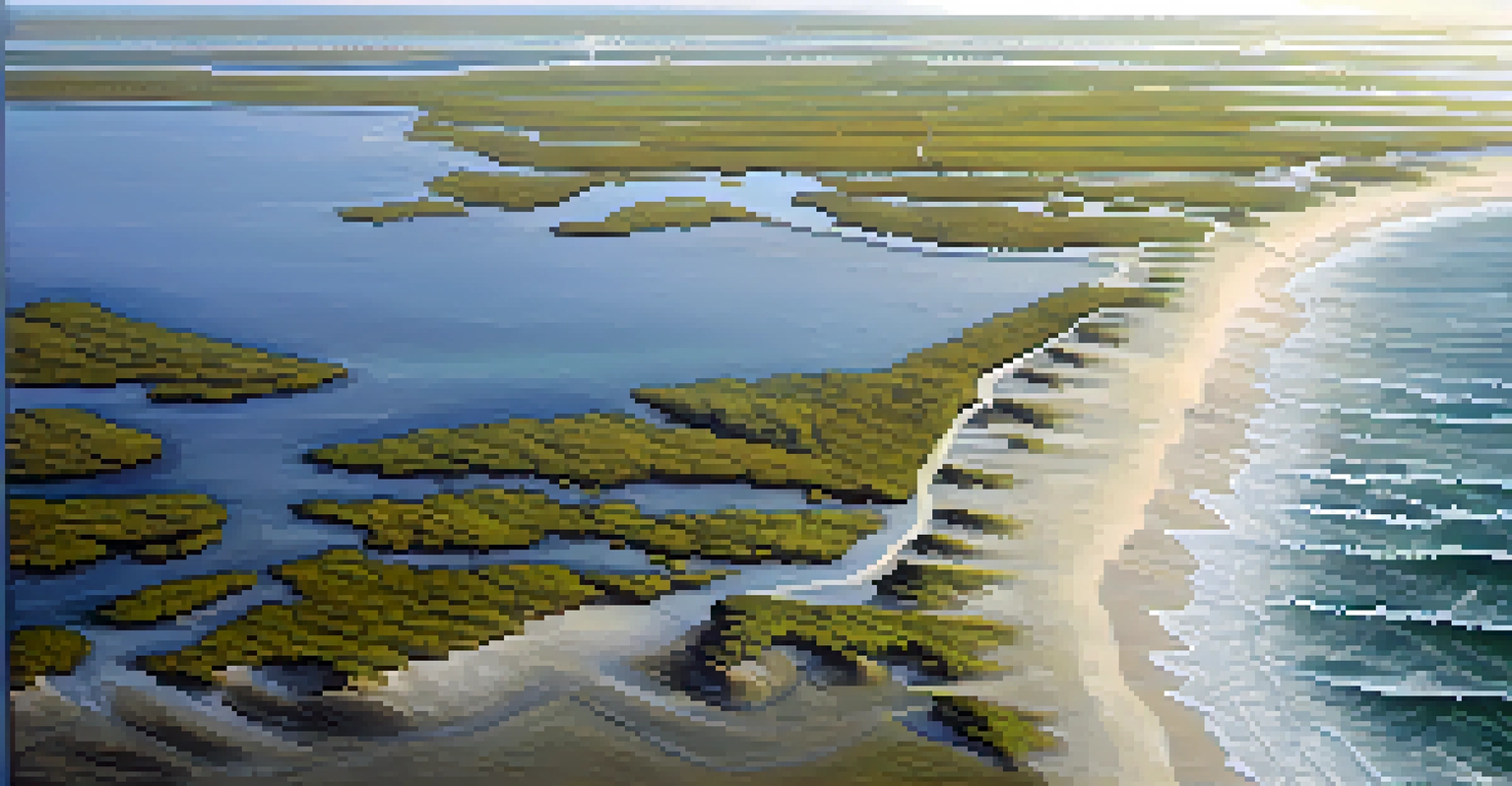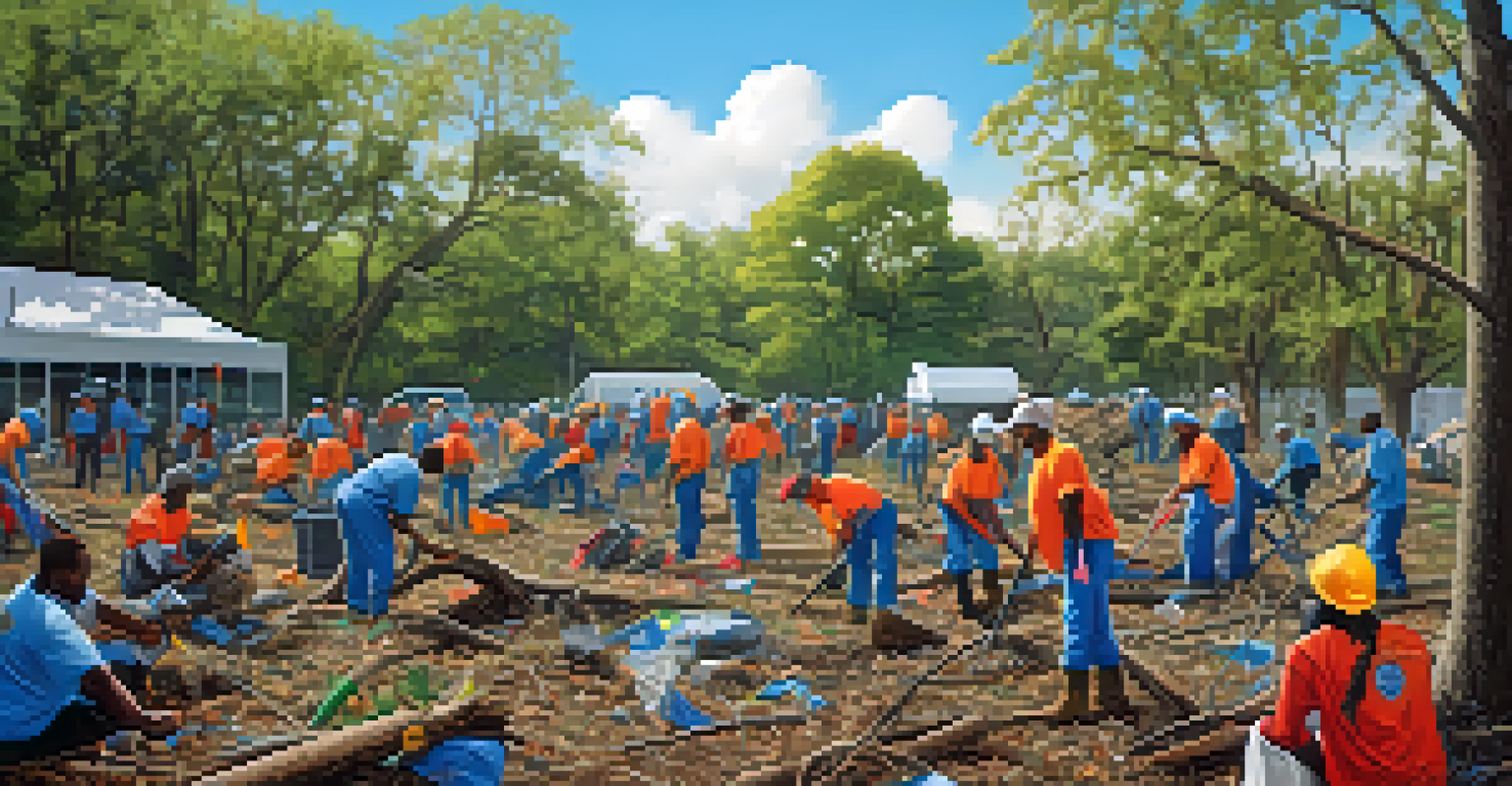Environmental Consequences of Hurricanes in Louisiana

The Intensity of Hurricanes and Their Ecological Footprint
Hurricanes are not just fierce storms; they leave a profound impact on the environment. These natural disasters can devastate ecosystems, uprooting plants and displacing animals as they sweep through. The sheer force of hurricane winds and storm surges can strip away layers of soil, affecting local flora and fauna for years to come.
The environment is where we all meet; where we all have a mutual interest; it is the one thing all of us share.
In Louisiana, where wetlands play a crucial role in absorbing storm impacts, hurricanes can lead to significant loss of these vital areas. The erosion of marshlands not only disrupts wildlife habitats but also diminishes the natural barrier that protects inland areas from future storms. Consequently, the ecological balance in these regions becomes increasingly fragile.
Moreover, the aftermath of hurricanes often sees the introduction of pollutants into the environment. Floodwaters can carry chemicals and waste from various sources, contaminating soil and water systems. This not only poses a threat to wildlife but can also affect human health and local economies reliant on clean resources.
Wetlands: Nature's Defense Against Hurricanes
Louisiana's wetlands act as a natural shield against hurricanes, absorbing storm surges and reducing flooding. These areas are vital for maintaining the health of the ecosystem, providing habitat for countless species and filtering pollutants from water. However, hurricanes can wreak havoc on these protective landscapes, leading to loss of biodiversity and increased vulnerability to future storms.

When a hurricane hits, the power of the storm can lead to the destruction of wetland vegetation, which is essential for stabilizing soil and supporting wildlife. Without this vegetation, the wetlands lose their ability to function effectively, resulting in more severe flooding and erosion during subsequent storms. This cycle can have long-term ecological consequences.
Hurricanes Devastate Ecosystems
Hurricanes severely disrupt local ecosystems by uprooting vegetation, displacing wildlife, and introducing pollutants.
Efforts to restore and conserve wetlands are crucial in mitigating the effects of hurricanes. By investing in these natural systems, Louisiana can bolster its defenses against future storms while promoting biodiversity and resilience in the face of climate change.
Coastal Erosion: A Growing Concern Post-Hurricane
Coastal erosion is a significant issue in Louisiana, exacerbated by hurricanes. The powerful winds and waves from these storms can accelerate the loss of coastal land, leading to a shrinking shoreline. This erosion not only impacts the natural landscape but also threatens communities and industries dependent on coastal resources.
We do not inherit the earth from our ancestors, we borrow it from our children.
As coastlines erode, habitats for various species, including fish and birds, can be lost. This not only disrupts local ecosystems but also affects the fishing and tourism industries, vital to Louisiana's economy. The loss of land can also increase the risk of flooding for inland communities, creating a ripple effect of environmental and economic challenges.
Addressing coastal erosion requires a multi-faceted approach, including restoration projects and sustainable development practices. By prioritizing these initiatives, Louisiana can work towards safeguarding its coastal regions for future generations and mitigating the impacts of hurricanes.
Impact on Aquatic Ecosystems After Hurricanes
Hurricanes significantly impact aquatic ecosystems, particularly in Louisiana's rich waterways. The influx of freshwater from heavy rains and storm surges can alter salinity levels, affecting the delicate balance of estuaries and coastal waters. This shift can have detrimental effects on marine life, including fish and shellfish populations.
Moreover, the turbulence created by hurricanes can lead to the resuspension of sediments, which can smother coral reefs and other essential habitats. The aftermath often sees a decline in biodiversity as species struggle to adapt to the sudden changes in their environment. This disruption can have long-lasting effects on the overall health of aquatic ecosystems.
Wetlands as Hurricane Shields
Louisiana's wetlands serve as natural barriers against storms, but hurricanes can destroy their protective vegetation, amplifying future risks.
Efforts to monitor and rehabilitate these ecosystems post-hurricane are crucial. By understanding the specific impacts on aquatic life, conservationists and policymakers can implement strategies to support recovery and promote resilience in the face of future storms.
Hurricane Debris: A Hidden Environmental Challenge
The debris left behind by hurricanes poses a significant challenge to the environment, particularly in Louisiana. Fallen trees, destroyed buildings, and other wreckage can create hazardous conditions for wildlife and disrupt natural habitats. This debris can also obstruct waterways, leading to further complications in managing stormwater and maintaining healthy ecosystems.
In addition to the immediate physical dangers, debris can introduce harmful materials into the environment. Chemicals from destroyed structures or vehicles can leach into the soil and water, posing risks to both wildlife and human health. Addressing this issue requires effective waste management and cleanup strategies to minimize environmental impacts.
Community involvement plays a critical role in debris removal and environmental recovery. By engaging local residents in cleanup efforts, Louisiana can foster a sense of stewardship and ensure that the natural environment is restored in a sustainable manner.
Climate Change: Amplifying Hurricane Effects in Louisiana
Climate change is an undeniable factor in the increasing intensity and frequency of hurricanes impacting Louisiana. Warmer ocean temperatures contribute to the formation of more powerful storms, leading to heightened risks for coastal communities. This trend not only threatens human lives and property but also exacerbates existing environmental challenges.
As storms become more severe, the effects on ecosystems are more pronounced. Wetlands, coastal areas, and aquatic habitats face increased pressure from rising sea levels and intensified storm surges. This leads to a cycle of deterioration that can jeopardize biodiversity and disrupt essential ecosystem services.
Community Role in Recovery
Community engagement is essential for rebuilding after hurricanes, fostering environmental stewardship and promoting restoration efforts.
Addressing the intersection of climate change and hurricane impacts requires a comprehensive approach. By investing in sustainable practices, habitat restoration, and climate adaptation strategies, Louisiana can work towards a more resilient future in the face of these growing challenges.
Community Response: Rebuilding After Hurricanes
In the aftermath of hurricanes, community response plays a crucial role in rebuilding both infrastructure and the environment. Residents often come together to assess damage, clear debris, and support one another in recovery efforts. This sense of community can be a powerful force in restoring the natural landscape and promoting environmental stewardship.
Grassroots organizations and local governments frequently collaborate on initiatives aimed at environmental restoration. From replanting trees to restoring wetlands, these efforts can enhance resilience against future storms while also fostering a deeper connection between residents and their environment.

Additionally, community engagement in environmental recovery can raise awareness about the importance of conservation. As residents witness the impacts of hurricanes firsthand, they may be more motivated to participate in preservation efforts, ensuring that Louisiana's unique ecosystems are protected for generations to come.
Looking Ahead: Strategies for Environmental Resilience
As Louisiana faces the reality of more frequent hurricanes, developing strategies for environmental resilience is vital. This includes investing in restoration projects, enhancing coastal defenses, and implementing sustainable land-use practices. By prioritizing these initiatives, the state can better protect its ecosystems and communities from future storm impacts.
Education and awareness are also key components in building resilience. Communities need to understand the importance of healthy ecosystems and how they contribute to disaster preparedness and recovery. By fostering a culture of environmental stewardship, Louisiana can empower residents to take an active role in protecting their natural resources.
Ultimately, resilience in the face of hurricanes is not just about recovery; it's about adapting and evolving with the changing climate. With a collective effort from government, communities, and individuals, Louisiana can pave the way for a sustainable future, ensuring that its rich environment continues to thrive.